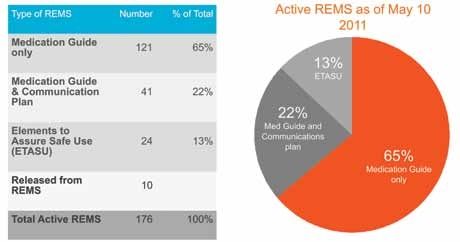Article
Ten REMS Throw Retirement Party
Author(s):
What you need to know about the latest draft guidance for manufactures regarding medication guides and the current scene of classwide REMs.
What you need to know about the latest draft guidance for manufactures regarding medication guides and the current scene of classwide REMs.
The Risk Evaluation and Mitigation Strategies (REMS) requirements imposed upon manufacturers have continued to evolve as the FDA and manufacturers negotiate and navigate through the complexity of implementation and management. Since Congress passed the Food and Drug Administration Amendments Act in September 2007, the FDA has mandated a total of 186 have a REMS program, the majority of which required only a Medication Guide or Medication Guide and Communication Plan.
Nevertheless, the implications of these REMS are being felt in every physician’s office, hospital, and pharmacy throughout the United States. Only 13% of REMS have elements to assure safe use (ETASU). These requirements are usually imposed by the FDA on drugs with more significant risks. The usual ETASU are prescriber and pharmacist training and certification, patient clinical monitoring and registry enrollment, controlled distribution, and dispensing with documented safe use conditions.
Despite the rapid rise in the number of REMS, there has been little data to show the impact of REMS on safety. Manufacturers have collected, assessed, and submitted a significant amount of data; however, these data are confidential and provided only to the FDA for review. Nevertheless, some emerging trends that are indicative of the general direction the FDA is taking with REMS.
Five percent of products with approved REMS have been released from REMS, beginning in December 2010 when the FDA released the orphan product, Sucraid, from its REMS that included rigorous ETASU. In 2009, when a manufacturing change occurred and to avoid a shortage of the orphan drug Sucraid, the agency required a REMS to monitor for serious adverse reactions. Since these have not occurred, the agency agreed to remove the REMS. In April, the FDA released an additional 9 products from REMS. Most of these were Medication Guide only REMS.
These actions appear to be linked to the Medication Guide (MedGuide) draft guidance for drug and biological products. In the guidance, the agency sought to clarify when a MedGuide should be given if a drug or biologic is administered by a health care professional versus when a product is dispensed directly to the patient for self-administration.1 It also provided details around how it will likely include a medication guide only as part of a REMS that has ETASUs.
In most cases, the FDA states the MedGuide will be included in a REMS only when elements to assure safe use are required. However, a MedGuide could be part of a REMS without ETASU if the FDA decides that the addition of a REMS will help to ensure that a drug’s benefits outweigh its risks. Perhaps the products with MedGuide only REMS did not sufficiently tip the scale to greater safety and the REMS was removed as a result.
Getting Serious About Classwide REMS
While on the one hand, the FDA is retiring REMS, it appears to be progressing with several classwide REMS that have been discussed for more than a year. The largest and most significant is the long-acting opioid REMS. The long-acting opioid class is the largest classwide REMS to date. There are approximately 1 million active Drug Enforcement Administration (DEA) prescribers, 4 million patients, and over 28 million prescriptions a year.
On April 19, 2011, the FDA issued updated requirements for this REMS, including a Medication Guide for each product, ETASU, and Assessment Timetable.2 Each manufacturer of a product in this class must ensure that prescribers of long-acting opioids complete a training course and pass a knowledge assessment offered by an accredited, independent continuing medical education provider. The education will not be mandatory, but it must inform prescribers on how to educate patients on safe use, storage, and disposal of long-acting opioids. Tools for managing patients, including patient provider agreements, are included in the REMS. A timetable for assessments is also required.
Many believe that this REMS design is less rigorous than many expected based on the advisory committee meeting recommendations last year. A major point is that this REMS is voluntary, not mandatory, unlike other classwide REMS such as the ESA REMS. Some support the educational component of the REMS transitioning to mandatory and being part of DEA registration. To link a REMS to DEA will take time, because it will require Congressional change to legislation.

New Analysis of REMS
Last month, the Center for Healthcare Supply Chain Research published its first research study, entitled “Assessing the Impact of Risk Evaluation and Mitigation Strategies (REMS) Requirements on the Pharmaceutical Supply Chain.”3 This study provides a good overview of the current REMS, landscape. It is a useful reference tool for those interested in learning more about REMS since it provides 2 case studies and analyzes the impact of REMS on the supply chain. SPT
References
1. www.fda.gov/Drugs/DrugSafety/ PostmarketDrugSafetyInformationfor PatientsandProviders/ucm111350.htm
2. www.fda.gov/downloads/Drugs/Guidance ComplianceRegulatoryInformation/ Guidances/UCM244570.pdf
3. www.hcsupplychainresearch.org/ projects/pdfs/20110405_APhA%20_REMS_ pharmacists.pdf

About the Author
Heather Morel is vice president of reimbursement & access solutions for McKesson Specialty Care Solutions in Scottsdale, Arizona. Ms. Morel leads the development and execution of reimbursement strategies and support services, patient assistance programs, risk evaluation and mitigation strategies programs, and other patient- and physician-focused initiatives. She is a nationally recognized expert in health care reimbursement and marketing. Ms. Morel is a member of the Specialty Pharmacy Times Editorial Board.





